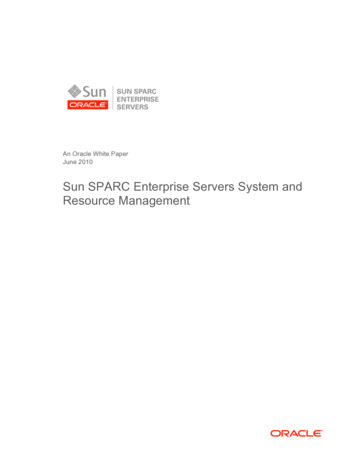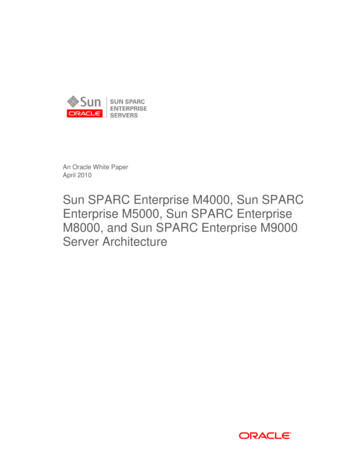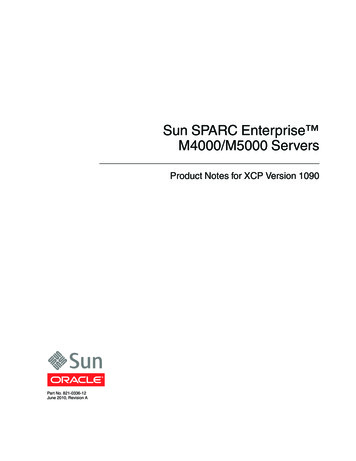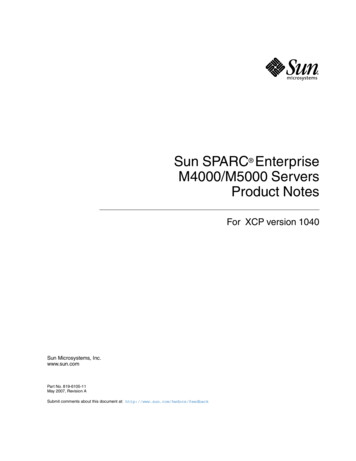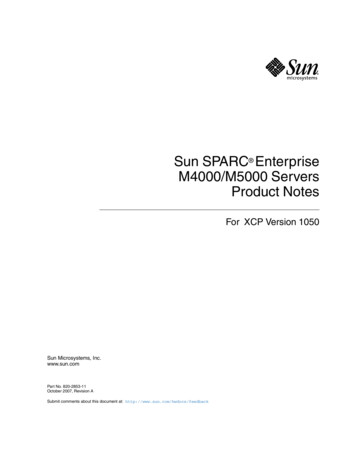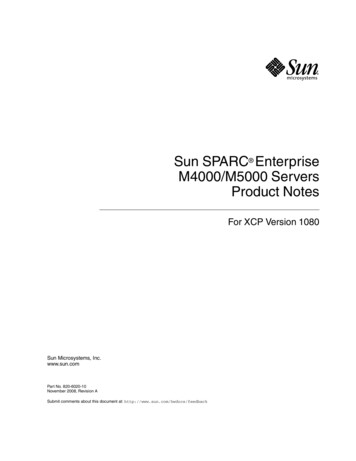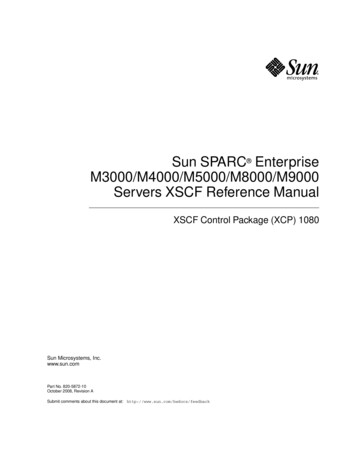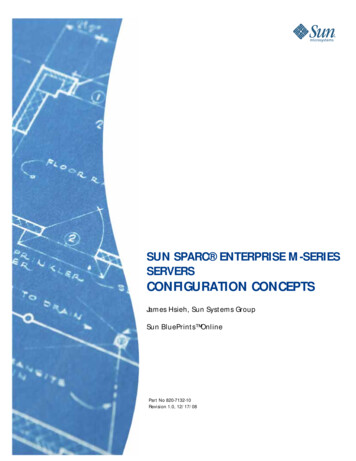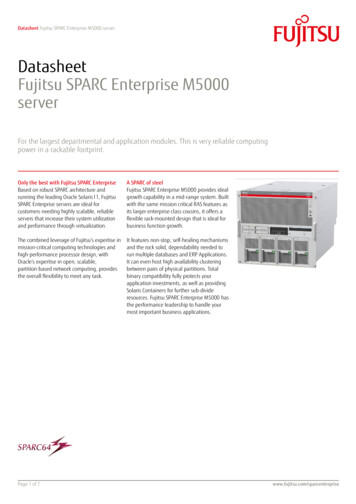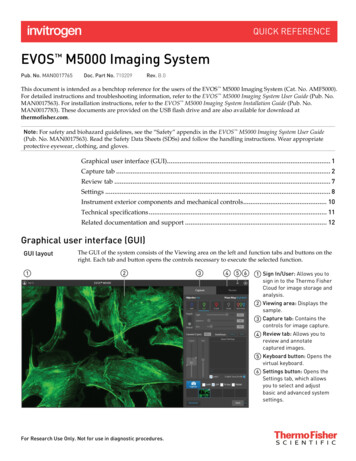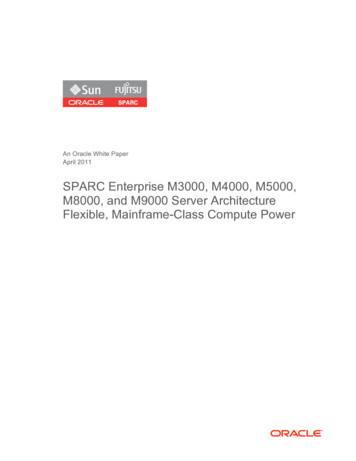
Transcription
An Oracle White PaperApril 2011SPARC Enterprise M3000, M4000, M5000,M8000, and M9000 Server ArchitectureFlexible, Mainframe-Class Compute Power
Oracle White Paper— SPARC Enterprise M3000, M4000, M5000, M8000, and M9000 Server ArchitectureIntroduction . 3SPARC Enterprise M-Series Servers from Oracle. 4Capabilities Overview . 4Entry-Level System — SPARC Enterprise M3000 Server. 7Midrange Systems — SPARC Enterprise M4000 and M5000 ServersHigh-End Systems — SPARC Enterprise M8000 and M9000 ServersMeeting the Needs of Commercial and Scientific Computing . 12System Architecture . 13System Component Overview . 13System Bus Architecture — Jupiter Interconnect . 19Interconnect Architecture . 19System Interconnect Reliability Features. 23Scalable Performance. 23SPARC64 VI, VII, and VII Processors . 24Next-Generation Processor Technology . 24Architecture of SPARC64 VI, VII, and VII Processors . 25I/O Subsystem . 36I/O Subsystem Architecture . 36Internal Peripherals. 39External I/O Expansion Unit . 39Reliability, Availability, and Serviceability . 41Redundant and Hot-Swap Components . 41Dynamic Domains . 41Dynamic Reconfiguration . 46Advanced Reliability Features . 46Error Detection, Diagnosis, and Recovery . 46System Management . 47Extended System Control Facility . 47Oracle Enterprise Manager Ops Center . 50Oracle Solaris 10 Operating System. 5389
Oracle White Paper— SPARC Enterprise M3000, M4000, M5000, M8000, and M9000 Server ArchitectureObservability and Performance. 53Availability . 54Security . 55Virtualization and Resource Management . 56Optimizing the Environment with Oracle Services and Training . 57Oracle Advanced Customer Services . 57Educational Services . 58A Variety of Learning Modes. 59Certification . 59Learning Credits. 59100% Student Satisfaction. 59Oracle Premier Support . 60Service and support to quickly diagnose and resolve issues. 60Tools and resources for proactive maintenance and to get the most of yourOracle products. 60Product innovation to keep pace with change and capitalize on newopportunities . 60Summary. 61For More Information . 62
Oracle White Paper— SPARC Enterprise M3000, M4000, M5000, M8000, and M9000 Server ArchitectureIntroductionOrganizations now rely on technology more than ever before. Today, compute systems play acritical role in every function from product design to customer order fulfillment. In many cases,business success is dependent on continuous availability of IT services. Once only required inpockets of the datacenter, mainframe-class reliability and serviceability are now essential forsystems throughout the enterprise. In addition, powering datacenter servers and keepingservices running through a power outage are significant concerns.While availability is a top priority, costs must also remain in budget and operational familiaritymaintained. To deliver networked services as efficiently and economically as possible,organizations look to maximize use of every IT asset through consolidation and virtualizationstrategies. As a result, modern IT system requirements reach far beyond simple measures ofcompute capacity. Highly flexible servers are required with built-in virtualization capabilitiesand associated tools, technologies, and processes that work to optimize sever utilization. Newcomputing infrastructures must also help protect current investments in technology andtraining.Oracle’s SPARC Enterprise M3000, M4000, M5000, M8000, and M9000 servers are highlyreliable, easy to manage, vertically-scalable systems with many of the benefits of traditionalmainframes — without the associated cost, complexity, or vendor lock-in. In fact, these serversdeliver a mainframe-class system architecture at open systems prices. With symmetricmultiprocessing (SMP) scalability from one to 64 processors, memory subsystems as large as4 TB, and high-throughput I/O architectures, SPARC Enterprise M-Series servers easilyperform the heavy lifting required by consolidated workloads. Furthermore, these servers run the powerful Oracle Solaris 10 operating system and include leading virtualizationtechnologies. By offering Dynamic Domains, eXtended system boards, DynamicReconfiguration, and Oracle Solaris Containers technology, SPARC Enterprise M-Seriesservers bring sophisticated mainframe-class resource control to an open systems compute1platform .1 SPARC Enterprise M3000 servers do not support Dynamic Domains, eXtended system boards, andDynamic Reconfiguration capabilities.3
Oracle White Paper— SPARC Enterprise M3000, M4000, M5000, M8000, and M9000 Server ArchitectureSPARC Enterprise M-Series Servers from OracleMassive compute power, a resilient system architecture, flexible resource control features, and theadvanced capabilities of Oracle Solaris 10 combine in SPARC Enterprise servers to provideorganizations a best-in-class enterprise platform. As an added benefit, SPARC Enterprise M3000,M4000, M5000, M8000, and M9000 servers (Figure 1) also offer improved performance over previousgenerations of Oracle’s Sun servers, with a clear upgrade path that protects existing investments insoftware, training, and datacenter practices. By taking advantage of SPARC Enterprise servers, ITorganizations can create a more powerful infrastructure, optimize hardware utilization, and increaseapplication availability — resulting in lower operational cost and risk.Figure 1. SPARC Enterprise M3000, M4000, M5000, M8000, and M9000 servers provide organizations with scalable power, reliability, and flexibilityCapabilities OverviewThe members of the SPARC Enterprise server family share many of the same capabilities that fosterpower, reliability, and flexibility. SPARC Enterprise M3000, M4000, M5000, M8000, and M9000servers feature a balanced, highly-scalable SMP design that utilizes the latest generation of SPARC64 processors connected to memory and I/O by a high-speed, low latency system interconnect thatdelivers exceptional throughput to applications. Also architected to reduce planned and unplanneddowntime, these servers include stellar reliability, availability, and serviceability capabilities to avoidoutages and reduce recovery time. Design features, such as advanced CPU integration and data pathintegrity, memory extended ECC, and memory mirroring, end-to-end data protection, hot-swappablecomponents, fault resilient power options, and hardware redundancy boost the reliability of theseservers.4
Oracle White Paper— SPARC Enterprise M3000, M4000, M5000, M8000, and M9000 Server ArchitectureSPARC Enterprise M4000, M5000, M8000, and M9000 servers also provide unmatched configurationflexibility. As in other Sun high-end servers, administrators can use Dynamic Domains to physicallydivide a single SPARC Enterprise M4000, M5000, M8000, or M9000 server into multiple electricallyisolated partitions, each running independent instances of Oracle Solaris. Hardware or software failuresin one Dynamic Domain do not affect applications running in other domains, unless the failedresource is shared across both domains.Dynamic Reconfiguration can then reallocate hardware resources among Dynamic Domains —without interrupting critical systems. SPARC Enterprise M4000, M5000, M8000, and M9000 serversadvance resource control one-step further with eXtended System Board (XSB) technology, supportingthe allocation of sub-system board resources such as CPUs, memory, and I/O components toDynamic Domains. The fine-grain resource control provided by eXtended System Board technologyhelps enterprises to further optimize resource utilization.Adding even more value, the range of compute power offered by the SPARC Enterprise server familyprovides the levels of vertical scalability required for many deployment classes, letting organizationsmatch the right system to the task. Rackmount SPARC Enterprise M3000, M4000, and M5000 serversare economical, powerful, and reliable servers that are well suited for entry-level and mid-range systemrequirements (Table 1). SPARC Enterprise M8000 and M9000 servers deliver the massive processingpower needed for high-end computing (Table 2).TABLE 1. CHARACTERISTICS OF SPARC ENTERPRISE M3000, M4000, AND M5000 SERVERSSPARC ENTERPRISESPARC ENTERPRISESPARC ENTERPRISEM3000 SERVERM4000 SERVERM5000 SERVERENCLOSURE2 rack units6 rack units10 rack unitsSPARC64 VI N/A 2.15 GHz 2.15 GHz 5 MB L2 cache 5 MB L2 cachePROCESSORS Up to four dual-core chips Up to eight dual-core chipsSPARC64 VII 2.52 GHz and 2.77 GHz 2.4 GHz with 5 MB L2 cache 2.4 GHz with 5 MB L2 cachePROCESSORS 5 MB L2 cache 2.53 GHz with 5.5 MB L2 cache 2.53 GHz with 5.5 MB L2 cache One CPU chip (quad-core or Up to four quad-core chips Up to eight quad-core chipsdual-core)SPARC64 VII 2.86 GHz 2.66 GHz with 11 MB L2 cache 2.66 GHz with 11 MB L2 cachePROCESSORS 5.5 MB L2 cache Up to four quad-core chips Up to eight quad-core chips Up to 64 GB Up to 256 GB Up to 512 GB Eight DIMM slots 32 DIMM slots 64 DIMM slots Four PCI Express Four PCI Express Eight PCI Express One CPU chip (quad-core ordual-core)MEMORYINTERNAL I/OSLOTSEXTERNAL I/O One PCI eXtended Two PCI eXtendedOne external x2 SAS portUp to two unitsUp to four units Serial Attached SCSI Serial Attached SCSI Serial Attached SCSICHASSISINTERNAL5
Oracle White Paper— SPARC Enterprise M3000, M4000, M5000, M8000, and M9000 Server ArchitectureSTORAGE Up to four drives Up to two drives Up to four drivesDYNAMIC DOMAINSOneUp to twoUp to four6
Oracle White Paper— SPARC Enterprise M3000, M4000, M5000, M8000, and M9000 Server ArchitectureTABLE 2. CHARACTERISTICS OF SPARC ENTERPRISE M8000, M9000-32, AND M9000-64 SERVERSSPARC ENTERPRISESPARC ENTERPRISESPARC ENTERPRISEM8000 SERVERM9000-32 SERVERM9000-64 SERVERENCLOSUREOne cabinetOne cabinetTwo cabinetsSPARC64 VI 2.28 GHz with 5 MB L2 Cache 2.28 GHz with 5 MB L2 cache 2.28 GHz with 5 MB L2 cachePROCESSORS 2.4 GHz with 6 MB L2 cache 2.4 GHz with 6 MB L2 cache 2.4 GHz with 6 MB L2 cache Up to 16 dual-core chips Up to 32 dual-core chips Up to 64 dual-core chipsSPARC64 VII 2.52 GHz and 2.88 GHz 2.52 GHz and 2.88 GHz 2.52 GHz and 2.88 GHzPROCESSORS 6 MB L2 cache 6 MB L2 cache 6 MB L2 cache Up to 16 quad-core chips Up to 32 quad-core chips Up to 64 quad-core chipsSPARC64 VII 3.0 GHz with 12 MB L2 cache 3.0 GHz with 12 MB L2 cache 3.0 GHz with 12 MB L2 cachePROCESSORS Up to 16 quad-core chips Up to 32 quad-core chips Up to 64 quad-core chipsMEMORY Up to 1 TB Up to 2 TB Up to 4 TB 128 DIMM slots 256 DIMM slots 512 DIMM slots32 PCI Express64 PCI Express128 PCI ExpressUp to 8 unitsUp to 16 unitsUp to 16 unitsINTERNAL Serial Attached SCSI Serial Attached SCSI Serial Attached SCSISTORAGE Up to 16 drives Up to 32 drives Up to 64 drivesDYNAMIC DOMAINSUp to 16Up to 24Up to 24INTERNAL I/OSLOTSEXTERNAL I/OCHASSISEntry-Level System — SPARC Enterprise M3000 ServerThe SPARC Enterprise M3000 server enclosure measures two rack-units (RU) and supports oneprocessor chip and up to 64 GB of memory. The SPARC64 VII/VII (dual-core or quad-core)processor chip is mounted on the motherboard. The I/O subsystem of the SPARC Enterprise M3000server features four short internal PCI Express slots, four internal disk drives, one internal DVD drive,and an external SAS port for attaching additional storage or tape device units. Two power supplies andtwo fan units power and cool the server. Front and rear views of the SPARC Enterprise M3000 serverare found in Figure 2.7
Oracle White Paper— SPARC Enterprise M3000, M4000, M5000, M8000, and M9000 Server ArchitectureFigure 2. SPARC Enterprise M3000 server enclosure diagramMidrange Systems — SPARC Enterprise M4000 and M5000 ServersSPARC Enterprise M4000 and M5000 servers are economical, high-power compute platforms withenterprise-class features. These midrange servers are designed to reliably carry datacenter workloadsthat support core business operations.SPARC Enterprise M4000 ServerThe SPARC Enterprise M4000 server enclosure measures six rack-units (RU) and supports up to fourprocessor chips, 256 GB of memory, and up to two Dynamic Domains. In addition, the SPARCEnterprise M4000 server features four short internal PCI Express slots and one short internal PCI-Xslot, as well as two disk drives, one DVD drive, and an optional DAT tape drive. Two power suppliesand four fan units power and cool the SPARC Enterprise M4000 server. Front and rear views of theSPARC Enterprise M4000 server are found in Figure 3.Figure 3. SPARC Enterprise M4000 server enclosure diagramSPARC Enterprise M5000 ServerThe SPARC Enterprise M5000 server enclosure measures 10 RU and supports up to eight processorchips, 512 GB of memory, and up to four Dynamic Domains. In addition, the SPARC Enterprise8
Oracle White Paper— SPARC Enterprise M3000, M4000, M5000, M8000, and M9000 Server ArchitectureM5000 server features eight short internal PCI Express and two short internal PCI-X slots, as well asfour disk drives, one DVD drive, and an optional DAT tape drive. Four power supplies and four fanunits power and cool the SPARC Enterprise M5000 server. Front and rear views of the SPARCEnterprise M5000 server are found in Figure 4.Figure 4. SPARC Enterprise M5000 server enclosure diagramHigh-End Systems — SPARC Enterprise M8000 and M9000 ServersHigh-end SPARC Enterprise servers are designed to deliver outstanding performance for even themost challenging workloads. By merging mainframe reliability, advanced performance technology oftenused in supercomputers, and an open systems environment, these servers help organizations createreliable, high-throughput, flexible solutions.SPARC Enterprise M8000 ServerThe SPARC Enterprise M8000 server is mounted in an enterprise system cabinet and supports up tofour CPU Memory Units (CMU) and four I/O Units (IOU). Fully configured, the SPARC EnterpriseM8000 server houses 16 processor chips, 1 TB of memory, 32 short internal PCI Express slots, andcan be divided into 16 Dynamic Domains. In addition, the SPARC Enterprise M8000 server supportsup to 16 disk drives, one DVD drive, and an optional DAT tape drive. Nine power supplies and 12 fanunits power and cool the SPARC Enterprise M8000 server. Front and rear views of the SPARCEnterprise M8000 server are found in Figure 5.9
Oracle White Paper— SPARC Enterprise M3000, M4000, M5000, M8000, and M9000 Server ArchitectureFigure 5. SPARC Enterprise M8000 server enclosure diagramSPARC Enterprise M9000-32 ServerThe SPARC Enterprise M9000-32 server mounts in an enterprise system cabinet and supports up toeight CMUs and eight IOUs. Fully configured, the SPARC Enterprise M9000-32 server houses 32processor chips, 2 TB of memory, 64 short internal PCI Express slots, and can be divided into 24Dynamic Domains. In addition, the SPARC Enterprise M9000-32 server supports up to 32 disk drives,one DVD drive, and an optional DAT tape drive. Power and cooling for the SPARC EnterpriseM9000-32 server is provided by 15 power supplies and 16 fan units. Front and rear views of theSPARC Enterprise M9000-32 server are found in Figure 6.10
Oracle White Paper— SPARC Enterprise M3000, M4000, M5000, M8000, and M9000 Server ArchitectureFigure 6. SPARC Enterprise M9000-32 server enclosure diagramSPARC Enterprise M9000-64 ServerAn expansion cabinet can be added to an existing base cabinet to create the SPARC Enterprise M900064 server, supporting up to 16 CMUs and 16 IOUs. Fully configured, the SPARC Enterprise M900064 server houses 64 processor chips, 4 TB of memory, 128 short internal PCI Express slots, and can bedivided into 24 Dynamic Domains. In addition, the SPARC Enterprise M9000-64 server supports upto 64 disk drives, two DVD drives, and two optional DAT tape drives. The SPARC Enterprise M900064 server utilizes 30 power supplies and 32 fan units for power and cooling. A front of the SPARCEnterprise M9000-64 server is found in Figure 7.11
Oracle White Paper— SPARC Enterprise M3000, M4000, M5000, M8000, and M9000 Server ArchitectureFigure 7. SPARC Enterprise M9000-64 server enclosure diagramMeeting the Needs of Commercial and Scientific ComputingSuiting a wide range of computing environments, SPARC Enterprise M-Series servers provide theavailability features needed to support commercial computing workloads along with the rawperformance demanded by high performance computing (HPC) (Table 3).TABLE 3. THE POWER AND FLEXIBILITY OF SPARC ENTERPRISE SERVERS BENEFIT A BROAD RANGE OF ENTERPRISE APPLICATIONSSPARC ENTERPRISE M3000, M4000, AND M5000 SERVERSSPARC ENTERPRISE M8000 AND M9000 SERVERS Server consolidation Server consolidation Business processing (ERP, CRM, OLTP, Batch) Business processing (ERP, CRM, OLTP, Batch) Database Database Decision support Decision support Datamart Data warehouses Web services IT infrastructure System and network management Application serving Application development Compute-intensive scientific engineering Scientific engineering12
Oracle White Paper— SPARC Enterprise M3000, M4000, M5000, M8000, and M9000 Server ArchitectureSystem ArchitectureContinually challenged by growing workloads and demands to do more with less, IT organizationsrealize that meeting processing requirements with fewer, more powerful systems can provide economicadvantages. In SPARC Enterprise M3000, M4000, M5000, M8000, and M9000 servers theinterconnect, processors, memory subsystem, and I/O subsystem work together to create a scalable,high-performance platform ready to address server consolidation needs. By taking advantage of theseservers, organizations can load multiple projects onto a single platform and accelerate applicationexecution at lower costs.System Component OverviewThe design of SPARC Enterprise M-Series servers specifically focuses on delivering high reliability,outstanding performance, and true SMP scalability. The characteristics and capabilities of everysubsystem within these servers work toward this goal. A high-bandwidth system bus, powerfulSPARC64 VI and SPARC64 VII/VII processors, dense memory options, and fast PCI Express(PCIe) and PCI eXtended (PCI-X) expansion slots combine within these servers to deliver high levelsof uptime and throughput, as well as dependable scaling for enterprise applications.System InterconnectBased on mainframe technology, the Jupiter system interconnect fosters high levels of performance,scalability, and reliability for SPARC Enterprise M-Series servers. A single system controller withinSPARC Enterprise M3000 servers and multiple system controllers and crossbar units within SPARCEnterprise M4000, M5000, M8000, and M9000 servers provide point-to-point connections betweenCPU, memory, and I/O subsystems. Offering more than one bus route between components enhancesperformance and allows system operation to continue in the event of a faulty switch. Indeed, thesystem interconnect used in these servers delivers as much as 737 GB/second of peak bandwidth,offering substantially more system throughput than Oracle’s previous generation of high-end servers.Additional technical details for the system interconnect within each SPARC Enterprise server arefound in Chapter 3 – System Bus Architecture.The SPARC64 VI, VII, and VII ProcessorsSPARC Enterprise M3000 servers support SPARC64 VII processors while SPARC EnterpriseM4000, M5000, M8000, and M9000 serves can utilize SPARC64 VI, VII, and VII processorsdeveloped by Fujitsu. The design of the multi-core, multithreaded SPARC64 VI and SPARC64VII/VII processor is based on several decades of experience in creating mainframe systems thatachieve high levels of reliability and performance. The SPARC64 VI dual-core, multithreadedprocessor takes advantage of 90 nm technology while the SPARC64 VII/VII processor provides aquad-core implementation with a faster clock speed and a reduction in size using 65 nm fabrication.Both processors execute at a power consumption level below 150 Watts. Moreover, the SPARCEnterprise M4000, M5000, M8000, and M9000 servers increase flexibility and maintain investmentprotection by supporting configurations that can mix SPARC64 VI, VII, and VII processors within13
Oracle White Paper— SPARC Enterprise M3000, M4000, M5000, M8000, and M9000 Server Architecturethe same system board. Additional technical details about the SPARC64 processor are found inChapter 4 – SPARC64 VI and SPARC VIIVII Processor.MemoryThe memory subsystem of SPARC Enterprise M3000, M4000, M5000, M8000, and M9000 serversincreases the scalability and throughput of these systems. In fact, the SPARC Enterprise M9000 serveraccommodates up to 4 TB of memory. SPARC Enterprise M3000 servers support DDR-II DIMMswith 2-way memory interleave. SPARC Enterprise M4000, M5000, M8000, and M9000 servers useDDR-II DIMM technology with 8-way memory interleave to enhance system performance. Whilemultiple DIMM sizes are not supported within a single bank, DIMM capacities can vary across systemboards. Available DIMM sizes include 1 GB, 2 GB, 4 GB, and 8 GB densities. Further details aboutthe memory subsystems are included in Table 4.TABLE 4. MEMORY SUBSYSTEM RISEM3000 SERVERM4000 SERVERM5000 SERVERM8000 SERVERM9000-32M9000-64SERVERSERVER64 GB256 GB512 GB1 TB2 TB4 TBDIMM SLOTS83264Up to 128Up to 256Up to 512BANK SIZE4 DIMMs4 DIMMs4 DIMMs4 DIMMs4 DIMMs4 DIMMsNUMBER OF2816Up to 16Up to 32Up to 64MAXIMUMMEMORYCAPACITYBANKSBeyond performance, the memory subsystem of SPARC Enterprise M3000, M4000, M5000, M8000,and M9000 servers are built with reliability in mind. ECC protection is implemented for data stored inmain memory, and the following advanced features foster early diagnosis and fault isolation thatpreserve system integrity and raise application availability. Memory patrol — Memory patrol periodically scans memory for errors. This proactive functionprevents the use of faulty areas of memory before they can cause system or application errors,improving system reliability. Memory Extended-ECC — The memory Extended-ECC function of these servers providessingle-bit error correction, supporting continuous processing despite events such as burst read errorsthat are sometimes caused by memory device failures. This feature is similar to IBM’s Chipkilltechnology.14
Oracle White Paper— SPARC Enterprise M3000, M4000, M5000, M8000, and M9000 Server ArchitectureMemory MirroringSPARC Enterprise M4000, M5000, M8000, and M9000 servers support memory mirroring capabilities.Memory mirroring is an optional, high-availability feature appropriate for execution of applicationswith the most stringent availability requirements. When memory mirroring mode is enabled on SPARCEnterprise M4000, M5000, M8000, and M9000 servers, the memory subsystem duplicates the data onwrite and compares the data on read to each side of the memory mirror. In the event that errors occurat the bus or DIMM level, normal data processing continues through the other memory bus andalternate DIMM set. In SPARC Enterprise M4000 and M5000 servers, memory is mirrored within thesame memory module, using the common memory address controller (MAC) Application SpecificIntegrated Circuit (ASIC) (Figure 8 and Figure 9).Figure 8 SPARC Enterprise M4000 server memory mirroring architectureFigure 9. SPARC Enterprise M5000 server memory mirroring architecture15
Oracle White Paper— SPARC Enterprise M3000, M4000, M5000, M8000, and M9000 Server ArchitectureOn SPARC Enterprise M8000 and M9000 servers, memory is mirrored across adjacent MAC ASICs toincrease reliability (Figure 10). However, in a Quad-XSB configuration, paired DIMMs are split acrossdifferent SPARC Enterprise M8000 and M9000 Quad-XSBs. As such, memory mirroring is notsupported on a Quad-XSB configuration.Figure 10. SPARC Enterprise M8000 and M9000 server memory mirroring architectureSystem ClockWhile the implementation of the system clock varies with the member of the SPARC Enterprise serverfamily, each server is engineered with reliability in mind. In particular, the SPARC Enterprise M8000servers clock chip is built with redundant internal components. Further enhancing availability andeasing maintenance, the SPARC Enterprise M9000 server also implements two sources of clock signaland a dual signal source synchronous line exists between the clock chip and the system boards. In theevent one route fails, the system can be restarted via the other route.16
Oracle White Paper— SPARC Enterprise M3000, M4000, M5000, M8000, and M9000 Server ArchitecturePCI Express and PCI-eXtended TechnologySPARC Enterprise M-Series servers use a PCI bus to provide high-speed data transfer within the I/Osubsystem. In order to support PCI Express expansion cards, SPARC Enterprise M3000, M4000,M5000, M8000, and M9000 servers use a PCI Express physical layer (PCI Express PHY) ASIC tomanage the implementation of the PCI Express protocol. PCI Express technology doubles the peakdata transfer rates of original PCI technology and reaches 2.5 Gb/second of throughput. In fact, PCIExpress was developed to accommodate high-speed interconnects such as Fibre Channel, InfiniBand,and Gigabit Ethernet. SPARC Enterprise M4000, M5000, M8000, and M9000 servers also supportPCI-X expansion cards for fast access to external devices. PCI-X is backward compatible with existingPCI cards, but increases bandwidth supporting data transfer of up to 1 GB/second for 64-bit devices.Additional technical details for SPARC Enterprise server I/O subsystems can be found inChapter 5 – I/O Subsystem.Service Processor – Extended System Control FacilitySimplifying management of compute systems leads to higher availability levels for hosted applications.With this in mind, SPARC Enterprise M-Series servers include an eXtended System Control Facility(XSCF). The XSCF consists of a dedicated processor that is independent of the server and runs theXSCF Control Package (XCP) to provide remote monitoring and management capabilities. Thisservice processor regularly monitors environmental sensors, provides advanced warning of potentialerror conditions, and executes proactive system maintenance procedures as necessary. Indeed, whilepower is supplied to the server, the XSCF constantly monitors the platform even if the system isinactive. XCP facilitates Dynamic Domain configuration, audit administration, hardware controlcapabilities, hardware status monitoring, reporting, and handling, automatic diagnosis and domainrecovery, capacity on demand operations, and XSCF failover services. Additional technical detailsabout the XSCF and XCP are found in Chapter 7 – System Management.Power and CoolingSPARC Enterprise M-Series servers use separate modules for power and cooling. Sensors placedthroughout the system measure temperatures on processors and key ASICS as well as the ambienttemperature at several location. Hardware redundancy in the power and cooling subsystems combinedwith environmental monitoring keep servers operating even under power or fan fault conditions.Fan UnitFully redundant, hot-swap fans function as the primary cooling system for SPARC Enterprise M3000,M4000, M5000, M8000, and M9000 servers (Table 5 and Table 6). If a single fan fails, the XSCFdetects the failure and switches the remaining fans to high-speed operation to compensate for thereduced airflow. SPARC Enterprise M-Series servers can operate normally under these conditions,allowing ample time to service the failed unit. Replacement of fans units can occur without interruptingapplication processing.17
Or
SPARC Enterprise M4000, M5000, M8000, and M9000 servers also provide unmatched configuration flexibility. As in other Sun high-end servers, administrators can use Dynamic Domains to physically divide a single SPARC Enterprise M4000, M5000, M8000, or M9000 server into multiple electrically
